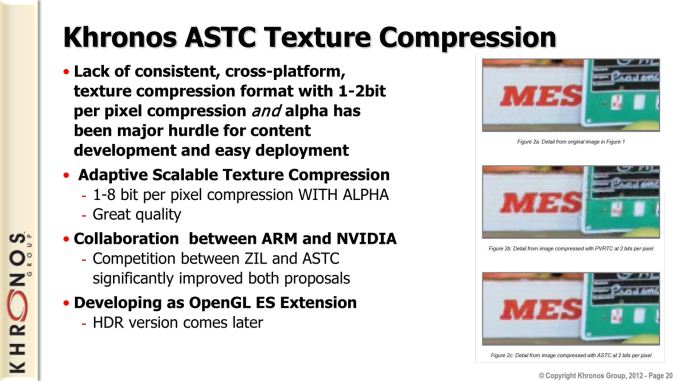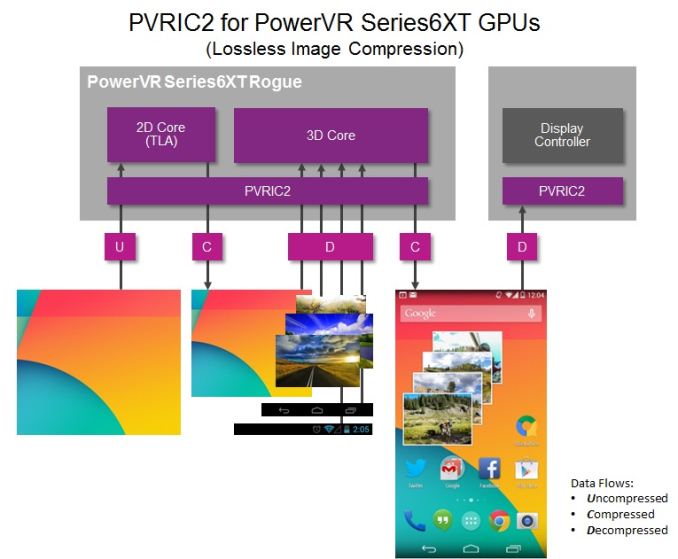Imagination Technologies Announces PowerVR Series6XT Architecture & GPUs
by Ryan Smith on January 6, 2014 10:01 AM EST
With CES taking place this week a number of mobile announcements are in the pipeline. And in what has become something of a tradition for Imagination Technologies, they are using the backdrop of CES to make their annual PowerVR product announcements.
The big news out of Imagination this year is that PowerVR Series6 will be getting a refresh, with the company announcing the existence of their new Series 6XT architecture and that it’s immediately available for licensing. Series6XT is designed to be a moderate feature upgrade and power/performance optimization pass for Series6, integrating various innovations over the past couple of years to keep Imagination’s designs performance and feature competitive. Series6XT comes 2 years after Series6 licensing was announced at CES 2012, and roughly half a year after the first SoCs implementing Series6 GPUs were released to consumers.
So what’s new in Series6? Although Imagination does like to keep to high level details in their CES announcements, nothing out of the Series6XT announcement makes it sound like we’re looking at a significant overhaul of the Series6 architecture. Which means it’s safe to assume that we’re still looking at Imagination maintaining their Unified Shading Cluster (USC) design, a 16-wide scalar SIMD with each slot capable of up to 4 FP32 ops per clock. Other aspects of the design have been changed – various other functional blocks have been updated with new features to improve performance – but the fundamental architecture and execution model would appear to remain unchanged.
Similarly, this means that API support also remains unchanged, with OpenGL ES 3.0 remaining as the baseline for all Series6XT parts. Though it’s not immediately clear whether any of these specific designs are available in a Direct3D 11_1 configuration too.
Taking a look at what changes have been made, Series6XT will be gaining finer grained power gating through what Imagination is calling “PowerGearing G6XT” technology. Mobile class GPUs have featured power gating for some time – it being necessary in order to achieve the low power consumption today’s mobile devices shoot for at idle and in light workloads – with higher grained solutions offering even more efficiency gains by being able to shut off a larger percentage of the GPU when those resources aren’t required. For Series6XT, Imagination gains the ability to shut off individual USCs and other processing blocks within their GPUs, which should be especially beneficial in light workloads where the GPU can’t idle, but it doesn’t need to allocate all of its resources either.
Meanwhile when it comes to performance Imagination has made several improvements and optimizations for Series6XT, with Imagination claiming performance gains of up to 50% versus Series6. Among other things, Imagination has specifically targeted front end and back end performance on Series6XT, nothing that they’ve made changes to improve sustained polygon and pixel fillrate performance. Though it’s not clear whether these are simply optimizations of their existing hardware or if those blocks have been outright widened for greater throughput.
Elsewhere Series6XT also includes a new iteration of Imagination’s Hierarchical Scheduling Technology (HST) to further improve resource utilization, along with performance optimizations that draw from instruction set streamlining and some compute-specific data path optimizations. Of course none of this takes into account clockspeeds either; while Imagination’s designs are intended to cover a range of clockspeeds based on power/performance requirements, it’s a safe bet that Series6XT is designed to clock higher than Series6, as GPU and CPU clockspeeds have ratcheted up over the years.
Series6XT’s final set of new features comes through what Imagination is calling “PVR3C”, which is a catch-all name for all of the various compression technologies that Series6XT supports. New to Series6XT is support for Adaptive Scalable Texture Compression (ASTC), a variable block size texture compression algorithm being blessed and promoted by Khronos as the next generation of texture compression for both mobile and desktop devices. ASTC is designed to improve texture compression efficiency both by improving the quality attainable at any compression ratio while allowing the use of larger blocks to further reduce the data size of textures, going up to a 36:1 ratio at a block size of 12x12. Though ASTC has yet to make it into the OpenGL ES core standard - it was finalized and ratified as an extension after OpenGL ES was approved - we wouldn't be surprised to see ASTC as a part of the OpenGL ES core standard by the time Series6XT hardware begins shipping. ASTC joins the other texture compression formats that the previous Series6 designs supported, including the PVRTC series and ETC.
Texture compression aside, Series6XT also includes updates for Imagination's lossless image compression technology. PVRIC, first introduced on the Series6 6x30 parts, is now up to PVRIC2, offering further improvements to compression throughput and performance. Rounding out the PVR3C collection is Imagination’s lossless geometry compression technology, PVRGC, which has actually been in the architecture since Series6, but until now has never had a formal name nor has it been widely discussed by Imagination. PVRGC is an in-flight (intermediate) geometry compression technology, intended to reduce the amount of bandwidth needed to shuffle geometry within the GPU and between the GPU and its external RAM, with an average compression ratio of 3:2.
Wrapping things up, as Imagination is announcing that Series6XT is available for immediate licensing, we already have some information on the GPU designs being released. Series6XT parts will be under the GX prefix, with the GX6240, GX6250, GX6450, and GX6650 designs being released today. As alluded to by the part numbers, GX6240 and GX6250 are two cluster parts, while GX6450 is a four cluster part and GX6650 is a six cluster part. Furthermore of those parts, GX6240 is an area optimized part, while the rest are performance optimized. With Series6XT focusing so much on performance and optimization improvements, although it’s not stated as such, for area efficiency in higher performance designs Imagination appears to be pushing customers towards smaller Series6XT designs, rather than having slower versions of larger designs.
| PowerVR Series6/6XT "Rogue" | ||||||||||||
| GPU | # of Clusters | # of FP32 Ops per Cluster | Total FP32 Ops | Optimization | ||||||||
| G6100 | 1 | 64 | 64 | Area | ||||||||
| G6200 | 2 | 64 | 128 | Area | ||||||||
| G6230 | 2 | 64 | 128 | Performance | ||||||||
| GX6240 | 2 | 64? | 128? | Area | ||||||||
| GX6250 | 2 | 64? | 128? | Performance | ||||||||
| G6400 | 4 | 64 | 256 | Area | ||||||||
| G6430 | 4 | 64 | 256 | Performance | ||||||||
| GX6450 | 4 | 64? | 256? | Performance | ||||||||
| G6630 | 6 | 64 | 384 | Performance | ||||||||
| GX6650 | 6 | 64? | 384? | Performance | ||||||||
It’s worth noting that Imagination’s earlier Series6 designs also topped out at six clusters with G6630, so while Imagination is scaling up performance internally, we’re not seeing them go with outright wider GPUs for the Series6XT family (at least not yet). So Series6XT’s performance improvements will come from these internal changes, including performance optimizations and any wider blocks within.
Finally, while Imagination doesn’t provide a timeframe for consumer availability (since they only sell designs to chipmakers), based on the amount of time needed to integrate these designs into new products and then get those products in the hands of consumers, we should be looking at a timetable similar to the original Series6 designs. In which case Series6XT equipped SoCs would start appearing in 2015, likely in the latter half.













22 Comments
View All Comments
Krysto - Monday, January 6, 2014 - link
So the next iPad will need GX6650 to be competitive with Tegra K1, otherwise fail. It's nice to see both them and Nvidia are adopting ASTC.name99 - Monday, January 6, 2014 - link
It is highly likely that the next Apple GPU will be Apple custom, following the pattern they have established with CPUs.They appear to have had the necessary design skills internally for a while, and custom allows them to optimize for what they care about without having to be slowed by someone else's schedule. It also allows them to start typing together their various bits and pieces (cores, L3, GPU, memory controller) using a fast ring like Intel, not limited to whatever standard ARM bus a 3rd party GPU supports.
What's interesting (for Apple) here is the various "eco-system standard" pieces, like ATSC and geometry compression, which Apple will presumably include in their device. But not the precise device itself.
stingerman - Monday, January 6, 2014 - link
The strong argument can be made that Tegra K1 will need iOS, otherwise fail. Unfortunately for Nvidia, Apple is a large shareholder of Imagination and repeatedly ahead of the mobile GPU curve.Bawl - Monday, January 6, 2014 - link
I don't know if Apple would be able to do that, but GX6650 seems to be a much better fit than G6630 for their next A8. Apple certainly loves all those new battery optimisations. And without them, G6630 seems to be quite battery hungry.Once again thanks for this analyse. I love so much all your GPUs articles. Especially when it's about Imagination GPUs (big fan since the Dreamcast).
alexvoica - Friday, January 10, 2014 - link
G6630 is still a pretty efficient design. If you read the original press release/blog article we've done at launch, it mentions a number of key features: PowerGearing, PVRIC (1st gen image compression), PVRGC and PVRTC1/2.GX6650 upgrades that feature set to PowerGearing GXT, PVRIC2 (2nd gen image compression), PVRGC and ASTC+PVRTC1/2, together with the overall performance boost.
Best regards,
Alex.
da_asmodai - Monday, January 6, 2014 - link
Does Anandtech just not review Snapdragon all of a sudden? The already announced Snapdragon 805's Adreno 420 GPU supports ASTC so how is "Series6XT is the first design we’ve seen with support for ASTC"? Both Imagination Technologies and nVidia are playing catchup on spec sheets here with Qualcomm and who knows who will actually have products on store shelves for consumers first.stingerman - Monday, January 6, 2014 - link
Qualcomm makes GPUs? ;)ssiu - Monday, January 6, 2014 - link
It takes 2 years for a "refresh"? Is there any performance claim from the company compared to the similar Series6 parts? (x % faster at same power / y % lower power at same performance etc.) It seems underwhelming for something 2 years newer ...alexvoica - Friday, January 10, 2014 - link
I've mentioned in the corresponding blog article, thata) Series6XT GPUs are up to 50% faster compared to their Series6 counterparts, clock for clock, cluster for cluster
b) these performance claims are based on well known graphics benchmarks
Regards,
Alex.
name99 - Monday, January 6, 2014 - link
"Imagination’s press release doesn’t make it clear where PVRGC in particular is implemented, but from the description it sounds like this is an in-flight geometry compression technology, intended to reduce the amount of bandwidth needed to shuffle geometry within the GPU and between the GPU and its external RAM."I have to wonder if this will be externally usable.
While Apple Maps 3D mode is pretty awesome (in cities where it is supported --- yes yes, we all know Apple Maps sux in your particular city, blah blah) it's most obvious visual flaw is the coarse-grained geometry. It's especially obvious in the rendition of trees which look, let's say, *OK*, but not much better than that.
It's not clear to me if the bottleneck here is the amount of geometry Apple wants to send over the network (especially since at least some people are going to be using this with metered cellphone connections) or if the problem is the amount of geometry a low-end iOS device can support.
Either way, I think geometry compression (especially if Apple can use it to pump out better geometry over the cell network) is actually a nice step forward, of interest to more than just the usual gaming crowd.